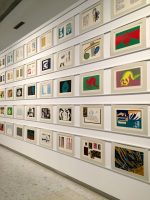19.10.16
Blogger: Jessie Cohen
We’ve recently had two major shows in Johannesburg in which prints have dominated: I Invented Myself by Walter Battiss at Wits Art Museum (WAM), which runs until the end of the month, and Rhythm and Meaning by Henri Matisse at the Standard Bank gallery, which came down in September. At the Battiss show, there is an entire wall of silkscreen prints and at Standard Bank, Matisse’s Jazz portfolio (lithographs) was the centrepiece.
Battiss silkscreens at WAM:
I went along to I Invented Myself with DKW master printer, Jill Ross, to get an insight into how a printmaker views the exhibition and to gage her thoughts on this spike in the platforming of prints in major SA exhibitions. We had already seen the show and were struck by the awesome scale of prints on display together with the innovative way in which they were hung on one huge wall.
On arrival, we found that the museum was closed due to the #FeesMustFall student shut down at Wits, so we peered through the windows and consulted the Battiss book that has been published in connection with the show. Our viewing capacity was limited, which forced us to make extra effort to engage with what we could see through the museum glass. Luckily, we had a clear view of the wall of silkscreens, which we could see in close-up by consulting the book.
Squinting through the glass and with the beautiful book in hand, it didn’t take long before Ross was on a roll…
“For a printmaker, looking at an exhibition means calling on your technical eye and unpacking the work piece by piece,” Ross tells me, explaining that she sees the merit of an artist (in terms of printmaking potential) by breaking down the various parts of their work: “if Battiss were alive today and a collaborator with DKW, I’d work with his use of colour and layers”, Ross says.
“Its great to see prints privileged in these big shows”, Ross adds, saying that “WAM [and Standard Bank] are doing a great thing by educating the SA public on this medium and creating more appreciation particularly among young emerging artists like the Wits art students who have immediate access to the space.”
Battiss’s prints are attributed considerable status in the show. Ross remarks that “like Pablo Picasso and William Kentridge, Battiss made prints for prints sake – not to service their drawing, for example.” Picasso is known to have been a great influence on Battiss and both Picasso and Kentridge are well-known for being prolific printmakers.
Ross: “WAM is Johannesburg’s major art museum, making it a particularly important space. The museum is accessible to a wide and vibrant audience so when you have print exhibitions like this all of a sudden it lends itself to being an educative force. As such an accessible space to artists and enthusiasts of all ages, it can showcase things that other places cannot. The interesting part, to me, is that when you see large walls full of prints like you do with this show, its truly amazing how it properly platforms printmaking as a practice and gives scope to the artist’s work in this medium, which is rarely seen.”
Before we leave, Ross takes a final look at the impressive wall of fifty silkscreens – many of which are playful and erotic in form – and comments on the connection with Matisse’s use of colour and form, saying “he’s taken Matisse’s work but made it more erotic and pushed it a bit further.”
Though limited, it was interesting to experience the show through Ross’s eyes and get a sense of how a master printer in SA experiences these shows.





